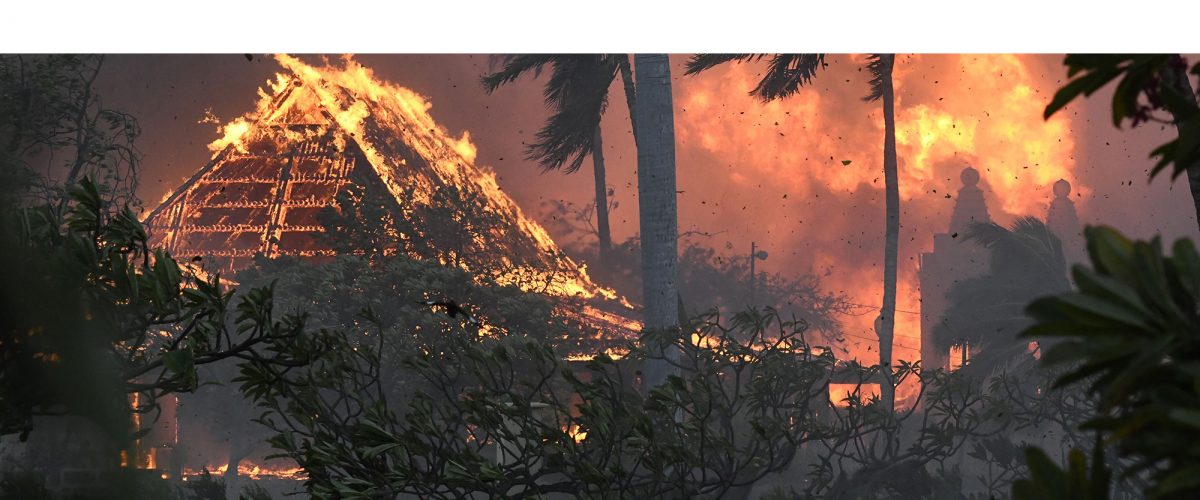As the Hawaii Conference of the United Church of Christ gathered for worship via Zoom Aug. 20, worshipers heard a bell toll 114 times.
That was one bell for every confirmed life lost in the wildfires that have ravaged parts of Maui. It took 4 minutes to ring the bell that many times.

Danette Kong
The memorial bells followed a reading from John 11:17-35, the story of Lazarus dying even though his friend Jesus had been summoned to come heal him. And the bells were followed by a prayer led by retired UCC chaplain Danette Kong, who voiced one of the most ancient prayers of the Christian church, “Kyrie eleison, Kyrie eleison, Kyrie eleison.”
Lord, have mercy.
Around the world, people watched video of the rapidly moving wildfires in horror and listened to the stories of residents fleeing their homes with seconds to spare between life and death. Former residents of Lahaina and those who have visited the historic town joined in mourning across the miles.
And some of the dead could not be found to be buried — their remains reduced to ashes — which is further complicating the assessment of how many people died. Some say the final death count could be up to 10 times what is known now.
Grief has piled on top of grief.
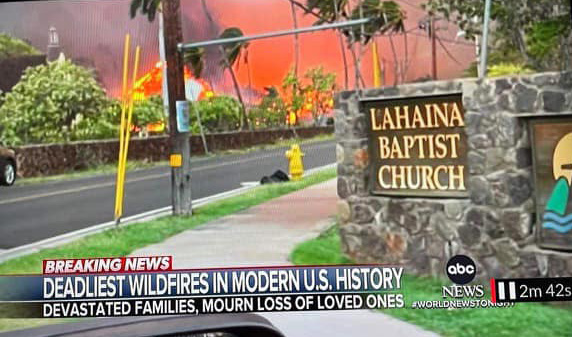
Religious centers burned
Because of the widespread destruction, many of the churches and religious centers that normally would be places of spiritual and physical refuge are not available. Those with physical structures remaining are doing all they can.
Iao Congregational Church on Maui has converted its Fellowship Hall to accommodate 50 cots for those without housing and is making other provisions for them.
Kahului Baptist Church has become an operations and distribution center for Southern Baptist Disaster Relief.
The Church of Jesus Christ of Latter-day Saints has sent $1 million to the American Red Cross to help with relief work.
Across all denominational and ecumenical lines, religious groups with a presence on Maui reported on the various ways they are offering assistance and on the number of places of worship destroyed by fire and wind.
The historic Holy Innocents Episcopal Church, located on Front Street in old Lahaina town, went up in flames quickly.
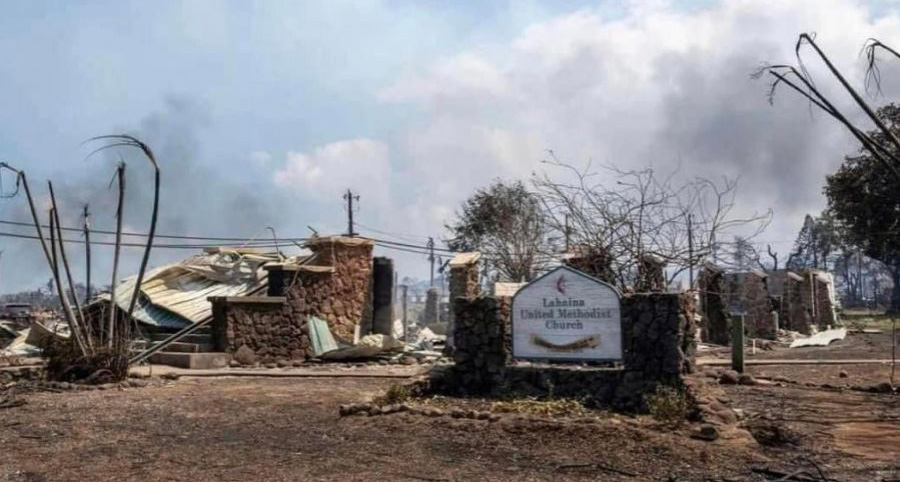
Lahaina United Methodist Church after the fire. (Photo: Lahaina United Methodist Church/Facebook)
Lahaina United Methodist Church also burned. Pastor John Crewe and his family were evacuated safely, and the pastor wrote on Facebook, “I really don’t have the words to express the grief that I am feeling now.”
The oldest Hawaiian church on Maui — Waiola Church, associated with the UCC — lost all its buildings in the fire. The only thing left standing was the front stone and back stone of the sanctuary with pillars from the side lanai and a flagpole with the Hawaiian flag flying over the grave of Keōpūolani, the “sacred wife” of Kamehameha I and mother of Kamehameha II and Kamehameha III. She is given credit for her role in the advancement of Christianity in the islands and helped found Waiola Church.
The three Japanese Buddhist temples in Lahaina also were destroyed — Lahaina Hongwanji Mission, Lahaina Jodo Mission and Lahaina Shingon Mission. All were more than 100 years old.
The Lahaina Hongwanji Mission — located next door to Waiola Church — was established in 1904, making it one of the oldest Buddhist temples on Maui. The temple, education building, kitchen and social hall were lost in the wildfires.
Meanwhile, Maria Lanakila Catholic Church in Lahaina appears to have been narrowly spared from the fire even though surrounding buildings were flattened. About 40% of Lahaina’s population is of Filipino descent, and many of those residents are members of this Catholic parish.
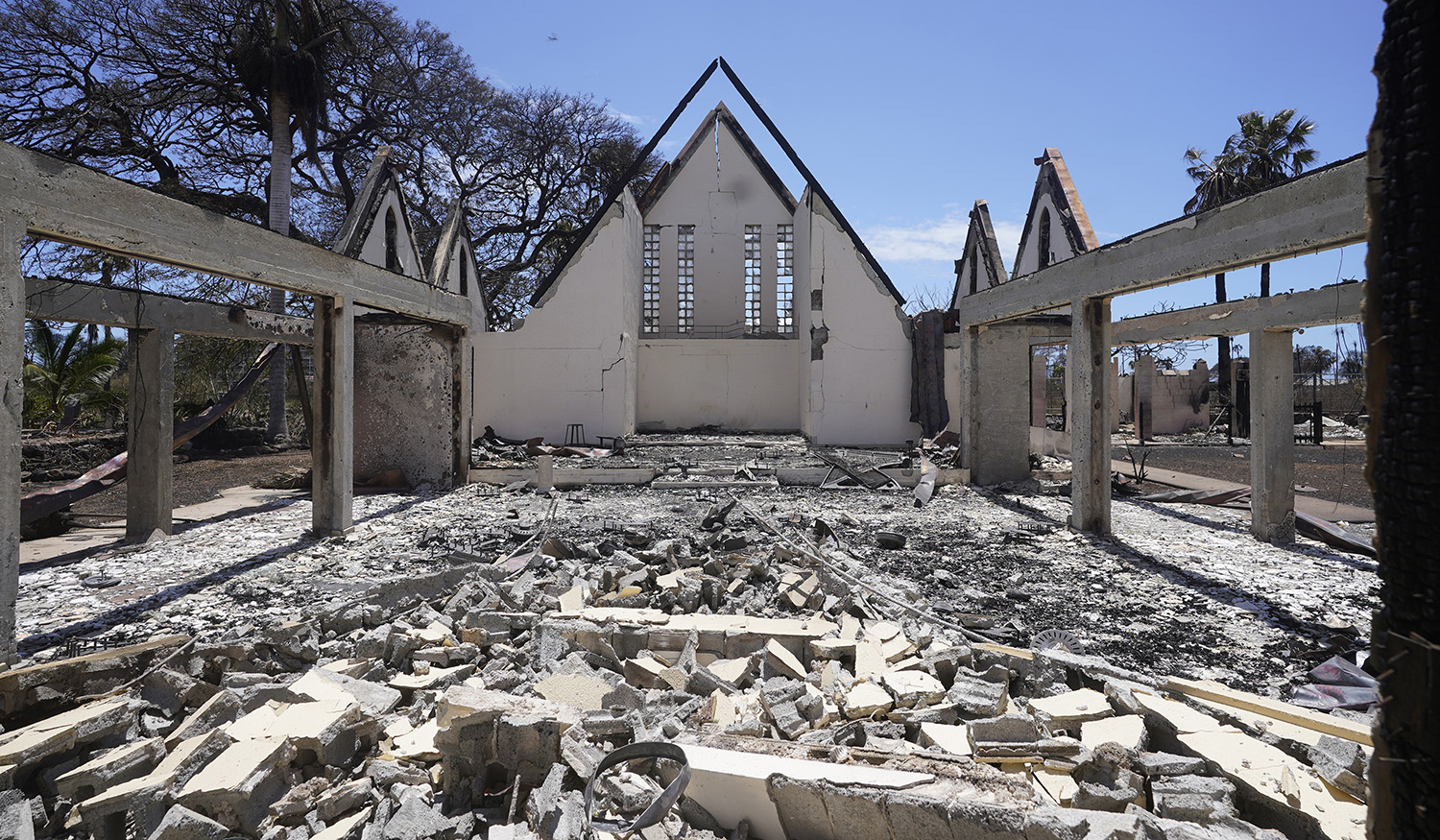
The destroyed Waiola Church is shown following the wildfire, Friday, Aug. 11, 2023, in Lahaina, Hawaii. (AP Photo/Rick Bowmer)
Religious diversity
Hawaii is home to a rich diversity of religious beliefs and practices. Although Christians make up the largest group and Protestants account for the largest share of Christians on the islands, many others have a strong and historic presence — from native religions to Buddhism and more.
The town of Lahaina served as the capital of the Hawaiian monarchy for 25 years in the 19th century before the capital moved to Honolulu. The town also is known for its history of whaling and religious missionaries.
“The cultural and historical significance of Lahaina cannot be underestimated,” Kong said. “It played a central role in the development of Christianity and the resistance to the overthrow of the monarchy. One of our leading historians, an atheist, maintains that the resistance was strongest in the churches, which kept parishioners informed and produced leaders — Native Hawaiians and even some missionaries — of the movement to support Queen Liliuokalani.”
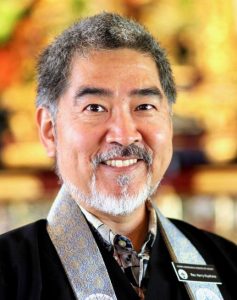
Kerry Kiyohara
Kerry Kiyohara is a Buddhist priest associated with the Hongwanji temples in Hawaii. He is Japanese, born and raised in Los Angeles and served many years as a marketing executive before becoming a priest about 10 years ago.
“All the Buddhist temples came to Hawaii during the wave of Japanese immigration in the late 19th century,” he said. “At one point, it is estimated Japanese immigrant workers accounted for 40% of the population of the Kingdom of Hawaii.
“Segregated into ethnic communities, the Japanese temples came to act as cultural and community centers during the plantation era, a role they continue to play to this day. The Japanese temples have also become part of the local community, as symbolized by the Bon Dance events that everyone, regardless of faith, race or social position, enjoys.”
Ironically, he noted, the Lahaina Hongwanji Bon Dance was scheduled for last week on Aug. 12-13, four days after the wildfires swept the region.
Looking for living water
Among Christians in Lahaina, Waiola Church is not only a landmark but a historical presence. The UCC church just celebrated its 200th anniversary in May.
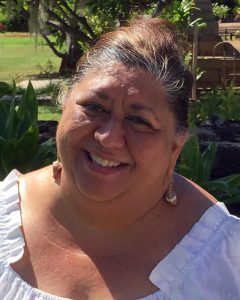
Anela Rosa
“Our intention for that celebration was to view and review the history of Waiola, but also the history of how the missionaries came to Maui and Lahaina,” said Pastor Anela Rosa. “In 200 years, the church has survived fire, storm, wind, destruction more than twice, and this is possibly the third or fourth time.”
Rosa, who is Hawaiian Portuguese, recounted the history of the church is tied to Queen Keōpūolani, who invited missionaries to come to Lahaina to teach the gospel. The queen also had a home in Lahaina. “From there, the church was founded, she gifted the community the property, the missionaries started their work.”
And then the queen “accepted Christ and was baptized before she passed away just shortly after,” Rosa said.
The loss of this church house is a loss to the entire community, the pastor explained. “For the people of Lahaina, just from my experience and knowing the community, it holds a very special meaning to all generations. I have had phone calls, emails, text messages over my 40 years here at Waiola with the term, ‘This is my family church,’ understanding they may not have been active members for 10, 20, 30 or so years. However, their memory at one point is where they did attend with their parents and grandparents.
“Our graveyard carries the history of those who built the kahua (foundation) from the past to where we are now.”
There’s hope for today in the history of the church’s name, Rosa said. “Waiola, once named Wainee (moving water), changed to Waiola (living water). The significance is that moving water can be damaging, so like the well or pool of Siloam — a live water, a blessing, for baptism, new birth, new life — the intention of the women to rename the church was to give it more meaning and to move away from the destruction of moving/damaging water.”
Waiola Church today — like many other faith communities in Lahaina — seeks to live up to its name and be a source of living water that cannot be quenched by a blazing fire.


